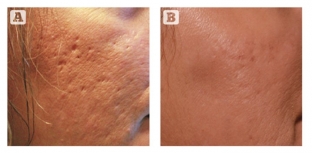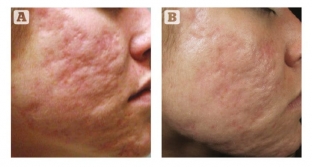The appearance of acne scars causes psychological discomfort for all patients, regardless of their age, gender and ethnicity. As a rule, such patients agree to almost any post-acne treatment, but often their expectations remain unjustified.
There are many reasons why post-acne therapy fails – starting with an incorrect definition of the type of scar and ending with the inability of the doctor to explain to the patient what results should be expected after the prescribed procedures. So Dr Brian Biesman and Molly Karz talk about a holistic approach to post-acne treatment and the important factors to consider when choosing a therapy.
Successful post-acne therapy: key aspects to consider
Today, post-acne day therapy is in the development stage. The advent of new products and technologies allows practitioners to offer their patients more therapies that provide results that were not previously possible.
The basis of successful treatment of post-acne is to accurately determine the nature of the patient's complaints, the correct identification of the types of scars, since there are certain effective therapeutic approaches for the treatment of each of them, as well as explaining to the patient the expected results.
An individual treatment plan can only be drawn up by taking into account all the above factors. Also, when developing a therapeutic plan, it is necessary to consider:
- patient's Fitzpatrick skin type;
- presence or absence of skin laxity;
- Relative balance of risks and expected benefits;
- recovery period;
- cost of procedures.
Follow us on Instsgram!
Determining the type of scar – a prerequisite for drawing up a post-acne therapy plan, since there is no single procedure that would provide excellent results in the treatment of all types of post-acne scars. According to the authors, there are 4 main types of post-acne:
- M-shaped scars (rolling scars);
- U-shaped scars (boxcar scars));
- V-shaped scars (ice-pick scars);
- atrophic scars.
In this article, the authors describe their approach to the treatment of various types of post-acne.
Correct determination of the type of scar – a prerequisite for drawing up a post-acne therapy plan.
Prior consultation – important step in post-acne therapy
Before proceeding with recommendations for post-acne treatment, it is imperative to conduct a preliminary consultation and determine what the patient really wants.
Based on their experience, the authors note that the majority of post-acne patients have already undergone procedures that have not provided significant clinical improvement.
The negative impact of acne and post-acne on the psychological state of patients cannot be overestimated. Therefore, the task of the doctor when working with such patients – not only to choose an adequate treatment plan, but also to explain what results should be expected.
Authors generally warn post-acne patients that optimal results cannot be achieved with just one treatment. It is important to explain to the patient that post-acne therapy – This is a marathon, not a sprint. It is important to warn the patient that the goal of treatment is to improve the quality of the skin in general, and that even after several treatments, post-acne cannot be completely eliminated.
Therefore, the task of the doctor when working with such patients – not only to choose an adequate treatment plan, but also to explain what kind of results should be expected.
At the same time, the authors note that even a decrease in the severity of post-acne leads to an increase in patients' self-esteem, which has a beneficial effect on many areas of their lives.
Peculiarities of post-acne therapy depending on the type of scars
Some patients who opt for post-acne therapy are more concerned about the presence of erythema (redness and inflammation of the skin) than about the texture or depth of the scars. It is important to ensure that patients are not using topical medications that can exacerbate inflammation. If an optimal topical treatment regimen is chosen, the authors generally use a long-pulse dye laser for the treatment of erythematous post-acne. In the case of dyschromia caused by photoaging, as well as erythematous post-acne, IPL therapy can be used.
Therapy for V-shaped acne scars (pitted scars)
V-shaped scars are difficult to treat. As a therapy for this type of post-acne, according to the observations of the authors, punch-excision with subsequent closure has proved to be the best. After that, patients are recommended to undergo a laser skin resurfacing procedure for more uniform scar healing. The nose, forehead, and medial midface regions sometimes do not respond as well to punch excision as the lateral cheeks due to thicker, oilier skin. Fortunately, this type of post-acne is quite rare.

Fig. 1 (A) before and (B) after post-acne treatment with punch-excision and skin resurfacing with a fractional ablative laser.
Therapy for M-shaped post-acne scars (rolling scars)
It is M-shaped scars that are most often found in the practice of the authors. For the treatment of mild forms of M-shaped post-acne, a non-ablative fractional laser can be used. More pronounced M-shaped scars are eliminated by aggressive subcision using an 18-gauge Nokor needle. Subcision is performed under local anesthesia. As a rule, patients note a subjective decrease in the severity of M-shaped scars by 30-90% (75% on average). In some cases, subcision may be performed several times.
To improve the results after subcision of the M-shaped post-acne, the authors perform a fully ablative or fractional ablative laser resurfacing (the procedure is performed in patients with Fitzpatrick type I–III skin types).
Patients with darker skin types may benefit from bipolar RF resurfacing or aggressive mesotherapy.
After surgical and apparatus procedures, in the presence of residual areas of depressions, in order to achieve the maximum effect of post-acne therapy, hyaluronic acid can be injected (for temporary improvement) or a filler based on collagen-coated PMMA microspheres for long-term improvement of results.

Fig. 2 (A) before and (B) after post-acne treatment with subcision and punch-excision followed by skin resurfacing with fractional ablative laser.
Therapy for U-shaped post-acne scars (boxcar scars)
As a rule, U-shaped post-acne scars are characterized by more pronounced atrophy and greater depth than M-shaped scars. The authors' experience shows that U-shaped scars sometimes respond to aggressive subcision therapy. If punch excision is used simultaneously to treat V-shaped scars, skin flaps can sometimes be placed in a pocket formed under deeper U-shaped scars.
Surgical excision may be needed to treat U-shaped post-acne – this depends on their size, localization and the relative atrophy of the overlying skin. Shallower scars with relatively good skin quality may respond to non-surgical treatments, while deeper, larger, or atrophic scars may require surgery for best results.
Injection techniques can also be used to correct U-shaped scars, especially in the absence of significant skin atrophy.
Peculiarities of therapy for atrophic post-acne scars
For the treatment of atrophic post-acne, multiple sessions of fractional ablative laser resurfacing are often best. Ablative fractional resurfacing can also be performed based on the relative severity of atrophic scars and the nature of other types of post-acne in the patient.
Many patients with atrophic scars benefit from poly-L-lactic acid (PLLA), which is both injected and applied topically during ablative fractional resurfacing.
Since most patients experience multiple types of post-acne at the same time, combination therapy is usually required to achieve maximum results.
Factors to consider in post-acne therapy
Ideally, post-acne therapy is not performed in the presence of active inflammatory lesions. Cysts should not be present in the area of surgical subcision or excision. If such lesions are present, vascular laser therapy may be considered. Ablative fractional resurfacing and aggressive
The severity of post-acne sometimes increases in patients with sagging skin caused by aging and photoaging.
Injectable post-acne fillers are suitable for patients who experience loss of facial volume, as well as a decrease in collagen and elastin in the skin.
Poly-L-Lactic Acid (PLLA) is often injected subcutaneously to improve skin firmness and reduce scarring. Soft tissue fillers can be combined with laser skin resurfacing. Superficial temporary fillers, including collagen and hyaluronic acid, are often injected to reduce the appearance of acne. In 2015, the FDA approved a PMMA-collagen filler (Belafill, Suneva, Inc.) for the treatment of acne scars.
As for mesotherapy, this technique has not been approved by the FDA as a post-acne treatment, however, based on their own experience, the authors note that aggressive mesotherapy can reduce the severity of all types of post-acne scars.
According to Prime magazineWith regard to mesotherapy, this technique has not been approved by the FDA as a post-acne therapy, however, based on their own experience, the authors note that aggressive mesotherapy can reduce the severity of all types of post-acne scars. The depth of exposure is selected in accordance with the thickness of the scar and the anatomical area of the face with which the doctor is working. Multiple treatments are required for best results. To date, the authors do not use mesotherapy as a first-line therapy for the treatment of post-acne, however, in some cases, they also resort to this method.






